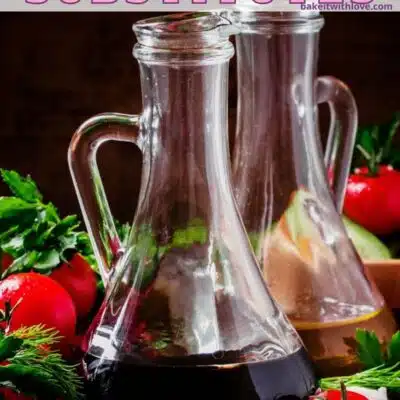If you're wondering what to use as a balsamic vinegar substitute to ensure that your recipe turns out wonderfully tasty, just read on! We've collected all of the very best alternatives that you can use whether you're temporarily out of balsamic or just not a super-fan (like us)!

Everything you need to know about how to best work around balsamic when you have a shortage!
You may know balsamic vinegar as the tasty companion to olive oil that is served with bread at Italian restaurants. While this tasty combo is one of the simple delights balsamic vinegar can offer, it is not the only thing.
Originating from Italy, this dark and richly flavored vinegar is used in making salad dressings and marinades. It is also a delicious topping for sweet and savory dishes.
Jump to:
- What Does Balsamic Vinegar Taste Like?
- The Best Substitutes for Balsamic Vinegar
- 1. Soy Sauce Blends
- 2. Soy Sauce + Grape Jelly + Red Wine Vinegar
- 3. Soy Sauce + Lemon Juice + Molasses
- 4. Red Wine Vinegar + Maple Syrup
- 5. Worcestershire sauce + Lemon Juice + Maple Syrup
- 6. Apple cider vinegar + Sugar
- 7. Fruit vinegar Blends
- 8. White Wine Vinegar + Sugar
- 9. Sherry Vinegar
- 10. Balsamic Vinaigrette
- 11. Lemon Juice + Lime Juice + Sugar
- Choosing the Best Substitute for Balsamic Vinegar
- 📖 Recipe Card
- 💬 Reviews
What Does Balsamic Vinegar Taste Like?
If you have not tasted balsamic vinegar before, it has a complex and rich flavor that comes from being aged in barrels for up to 12 months. This slow fermentation forms not only a rich flavor profile but also a thick and syrup-like consistency.
One distinct flavor profile of balsamic vinegar is its sweetness. This is distinctly different from many other kinds of vinegar that are primarily acidic.
Therefore, when looking for a substitute you will notice many of them have sugar added to mimic the sweetness.
The Best Substitutes for Balsamic Vinegar
Due to the complex flavor profile of balsamic vinegar, your best substitute will be one that reflects both the acidity and sweetness. There are not many other condiments that on their own can replicate these two flavors.
Therefore, the best substitute for balsamic vinegar will be a combination of at least two different ingredients.
To achieve the results from the mixtures below, it is important to thoroughly mix them. Use a whisk to mix them in a bowl or shake the ingredients in a glass jar. You can also use a blender for larger quantities.
Another tip is to let each mixture sit for just a minute to thicken up, then stir and use.
1. Soy Sauce Blends
The strong fermented flavor of soy sauce is a great choice for mimicking the acidity of vinegar. On its own, soy sauce has a very simple single flavor though.
Therefore, it needs to be combined with other ingredients to truly represent the taste of balsamic vinegar. This usually entails adding another acidic ingredient and a sweetener.
2. Soy Sauce + Grape Jelly + Red Wine Vinegar
Yes, you read that right. It sounds odd, but something about the flavor profile of grape jelly provides the perfect complex sweetness to mimic balsamic vinegar.
Moreover, the consistency of grape jelly is wonderful for creating the syrup-like consistency of balsamic vinegar. One thought about why this works so well is because balsamic vinegar is made from fermented grapes.
It’s also important to add another strong acidic taste to achieve the right balance of flavor.
Mix the following together to replace 1 tablespoon of balsamic vinegar.
- 1 tablespoon red wine vinegar
- ½ teaspoon grape jelly
- ¼ teaspoon soy sauce
PS. This is a personal fave, that's why it's tops here!!
3. Soy Sauce + Lemon Juice + Molasses
Another combination that many people find works well is soy sauce, lemon juice, and molasses. In this case, the lemon juice adds extra acid while the molasses brings sweetness.
Molasses is a great choice as a sweetener because it has a complex taste that helps mimic the elevated flavors of balsamic vinegar. It also adds the same syrupy consistency.
Begin by mixing equal parts of these 3 ingredients. The measurements below will make enough to replace 1 ½ tablespoons of balsamic vinegar.
- ½ tablespoon soy sauce
- ½ tablespoon lemon juice
- ½ tablespoon molasses
While this is a good starting point, you may need to adjust the volume of each ingredient to reach the desired taste and consistency for your recipe.
Don’t be afraid to add another splash of lemon juice for more acidity or a squeeze of molasses for more sweetness.
4. Red Wine Vinegar + Maple Syrup
Red wine vinegar has a strong acidic base that resembles the acidity of balsamic vinegar. As with most kinds of vinegar though, it is missing the sweetness.
To help replicate the sweet and tangy taste of balsamic vinegar, mix red wine vinegar with maple syrup. The rich flavor of maple syrup will provide a balanced sweet taste along with the desired consistency.
Mix 1 tablespoon of red wine vinegar with 2 teaspoons of maple syrup. Make sure you are using real maple syrup though and not manufactured syrup.
5. Worcestershire sauce + Lemon Juice + Maple Syrup
Worcestershire sauce is an excellent choice for adding flavor to meats and marinades. It has a complex flavor that comes from fermenting anchovies with other ingredients.
Due to Worcestershire’s strong flavor profile, it is best to balance it with a little bit of lemon. As with other fermented sauces, it is also lacking the unique sweetness of balsamic vinegar.
Real maple syrup is the best sweetener for this mixture. Its rich sweetness will help mellow the strong flavors of Worcestershire and enrich the acidity of the lemon.
Mix 1 tablespoon of Worcestershire sauce with 1-2 teaspoons of maple syrup and a small squeeze of lemon juice. As with other mixtures, you may need to add another splash or squeeze to make the taste just right.
With a similar consistency and complexity of balsamic vinegar, this works well for most recipes.
6. Apple cider vinegar + Sugar
Apple cider vinegar is a common base in salad dressings. Therefore, it can also provide a good base for salad dressings that call for balsamic vinegar.
Keep in mind though, that even though apple cider vinegar is made from fruit, it is not sweet. In fact, it is one of the stronger acidic vinegars. Therefore, it will need to be mixed with a sweetener.
Regular white sugar tends to work best for balancing the acidity of apple cider vinegar. Although, many cooks also like to use brown sugar to help mimic the color of balsamic vinegar.
Mix 1 tablespoon of apple cider vinegar with ½ tablespoon of sugar (or brown sugar) to equal 1 tablespoon of balsamic vinegar.
If you whisk or shake this mixture well, and let it sit for a few minutes afterwards, the sugar should dissolve. However, you can also mix this over very low heat to get a thicker syrup-like consistency.
7. Fruit vinegar Blends
Apples are not the only fruit used to make vinegar. As long as you can ferment a fruit, you can make vinegar from it.
While not as commonly sold in grocery stores, you may find a local fruit vinegar at a farmers market or local health food store. Maybe you have even made your own artisan vinegar, yum!!
These mixtures will vary depending on what type of fruit vinegar you have and what you are using it for. As a general guideline, mixing fruit vinegar with honey is favored for glazing fish, meats, and veggies.
Fruit vinegar mixed with brown sugar is favored for salad dressings.
Begin by mixing 1 tablespoon of your favorite fruit vinegar with ½ teaspoon of your sweetener of choice. If using brown sugar, mix over low heat to dissolve the granules. Taste and adjust as needed.
8. White Wine Vinegar + Sugar
White wine vinegar has a much more delicate flavor than balsamic vinegar. However, this is not a bad thing when you want a substitute that will not drastically change the flavor of your dish.
The mild flavor of white wine vinegar will offer a nice balanced acidity. Combined with a bit of white sugar, it gives the basic elements of balsamic vinegar.
Begin by mixing 1 tablespoon of white wine vinegar with ½ teaspoon of sugar. Adjust the taste as needed with more vinegar or sugar.
This light mixture is especially great for salad dressings or marinades for fish or vegetables. If you want a rich and heavy glaze though, consider one of the earlier suggestions above.
9. Sherry Vinegar
While most substitutes require a little bit of mixing, sherry vinegar is one that can be used on its own. However, most people do not have sherry vinegar in their cupboards. Therefore, it may not be a great option if you need it right away.
If you do have sherry vinegar though or prefer to use it over the balsamic vinegar, it is a great substitute!
This delightful vinegar provides a similar balance of both sweet and acidic flavors that are quite similar to balsamic vinegar.
Use sherry vinegar in a simple 1:1 exchange for balsamic vinegar in any recipe.
10. Balsamic Vinaigrette
If you have a bottle of balsamic vinaigrette dressing in your fridge, go ahead and give it a try! Made with balsamic vinegar and olive oil, it will provide you with some of the same rich flavors of balsamic vinegar on its own.
The flavor will be slightly different though since it is mixed with olive oil, and sometimes other seasonings as well. Therefore, you may want to do a small taste test before using it in your recipe.
The best part of this substitute though is that it is also a simple 1:1 ratio!
11. Lemon Juice + Lime Juice + Sugar
In a pinch, you can use a simple sweet and acidic combination to mimic the basic elements of balsamic vinegar. This will not work well for a complex glaze, but in a simple dressing or marinade, it can get the job done.
Simply mix equal parts lemon and lime juice and sugar, then taste. Add more citrus or sugar as needed. When you have a good flavor balance, measure in a 1:1 ratio for balsamic vinegar.
Choosing the Best Substitute for Balsamic Vinegar
As with any substitute, it is important to choose a substitute that works best for your dish. Since balsamic vinegar has such a unique and complex flavor, it will be difficult to match the taste exactly.
Therefore, choose the substitute that will best mimic the flavor and consistency of each individual recipe. For dressings, opting for a lighter vinegar and a sweetener will work best.
On the other hand, the soy sauce or Worcestershire blend will provide the complex color and richness needed for a glaze or marinade.
These are simply suggestions though, feel free to experiment with what you have in your kitchen and find the mixture that you like best. Be sure to let us know what you ended up trying out as a balsamic vinegar substitute in your recipes in the comments below!
Do you love a recipe you tried? Please leave a 5-star 🌟rating in the recipe card below and/or a review in the comments section further down the page.
Stay in touch with me through social media @ Pinterest, Facebook, Instagram, or Twitter! Subscribe to the newsletter today (no spam, I promise)! Don't forget to tag me when you try one of my recipes!
📖 Recipe Card
Best Balsamic Vinegar Substitute
Ingredients
Option 1 - Soy Sauce & Grape Jelly Blend
- 1 tablespoon red wine vinegar
- ½ teaspoon concord grape jelly
- ¼ teaspoon soy sauce
Option 2 - Soy Sauce & Molasses
- ½ tablespoon soy sauce
- ½ tablespoon lemon juice
- ½ tablespoon molasses
Instructions
Option 1 - Soy Sauce & Grape Jelly Blend
- Mix red wine vinegar, concord grape jelly, and soy sauce together until well blended and smooth. Use to replace 1 tablespoon of balsamic vinegar.
Option 2 - Soy Sauce & Molasses
- Mix equal parts of the three ingredients (soy sauce, lemon juice, and molasses) until well blended and smooth. Taste and adjust as needed.
Notes
- These are my two preferred balsamic vinegar substitutes to use, other than sherry vinegar.
Nutrition

Angela is an at home chef that developed a passion for all things cooking and baking at a young age in her Grandma's kitchen. After many years in the food service industry, she now enjoys sharing all of her family favorite recipes and creating tasty dinner and amazing dessert recipes here at Bake It With Love!







Traci McD says
I didn't taste this recipe yet because I need to know how much it makes using the measurements above and how much I would need of each ingredient (Soy sauce w/lemon juice and molasses) to get 1/2 C. of the substitution. Would you be so kind to let me know? Thank you!! Excited to try this in a marinade. 😁
Angela @ BakeItWithLove.com says
You need equal parts of each (soy sauce, lemon, and molasses) so I would use 2 tablespoons of each, then taste and adjust - 8 tablespoons per 1/2 cup. Have fun with it!